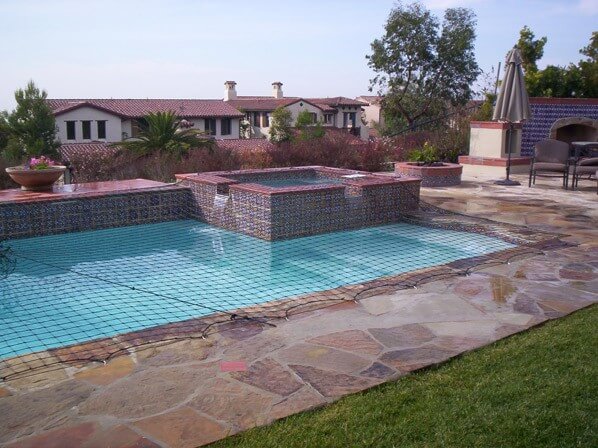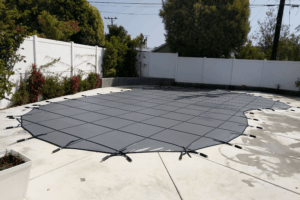
Pool Area Maintenance Tasks You Shouldn’t Skip
Even diligent pool owners miss key maintenance steps. Use this checklist to catch commonly forgotten tasks and keep your pool area safer and more efficient year-round.

There are many things we have to teach young children to keep them safe at the pool. We teach them how to swim properly, to walk (never run) on the deck, to only dive in the deep end, to respect the pool safety fence, and to never ever go swimming without supervision.
However, there’s one other aspect of pool safety you may not be mentioning: pool drain safety. While the drain is an essential part of your pool’s filtration system, it does present a certain amount of risk for swimmers — particularly those who are light and inexperienced in the water, like young children. Here are a few tips to help you avoid those pool drain dangers.
Most swimming pools and spas use a suction-based drain to filter out things like dirt, body oil, and debris from the water. This system helps to keep your pool water clean, which makes it an important part of your pool’s ecosystem. But just like a hot stove or a potentially-toxic cleaning product, your pool drain can present a real danger if it’s not used safely.
Because pool drains use suction to filter things out of the water, they put people at risk for entrapment. If a small, light person gets too close to a pool drain, they can become trapped underwater, which can lead to a host of injuries including accidental drowning.
This kind of swimming injury is rare; the CDC reports that there were only 33 cases between 2009 and 2013. However, those incidents resulted in serious injury a whopping 85% of the time — and nearly 70% of them happened to young children.
What can we do to prevent entrapment in the pool? The best things you can do are invest in proper equipment (like drain covers) and talk to your kids about these dangers. It’s critically important that parents teach their children to practice pool drain safety. It’s also essential to supervise children in pools and spas. Consider using a pool safety net or a mesh pool fence to keep kids away from the water and out of danger when you’re not able to watch them.

Pool drain safety isn’t just important for your children’s well-being — it’s actually the law. In 2007, President Bush signed the Virginia Graeme Baker Pool and Spa Safety Act (VGBA) into law. This act was named for Virginia Graeme Baker, a seven-year-old girl who tragically drowned after she became trapped underwater by a hot tub drain in 2002.
The VGBA requires that all pools and spas be fitted with “anti-entrapment drain covers.” Unlike the flat pool drains of old, these new models use a curved design, which makes it much more difficult to become trapped if you lean against it or sit on it.
If for whatever reason, a pool cannot be retrofitted with an anti-entrapment cover, the law requires that it instead add a safety measure to the filtration system. A safety vacuum release system (SVRS) or automatic pump shut off can be incredibly helpful in mitigating the dangers of pool drains.
If you’re visiting a public pool, or if your pool was built after 2008, you can be confident that the drain is likely VGBA-compliant. However, if you have an older pool, it is very important that you look into upgrading your drain. This simple act could be the thing that saves a child’s life.
When it comes to pool drain danger, there are five major forms of entrapment:
No one would ever want their children to suffer these scary, potentially devastating injuries. This is why we encourage parents to minimize the risk every time their kids go swimming.
If your child has long hair, tie it up in a bun. Make sure they remove any jewelry (particularly long necklaces) before getting into the water. And most importantly, teach your child how to practice pool drain safety. If you make these simple steps a part of your pre-swimming routine, you can feel more confident and secure when your kids are using the pool.
Teaching your children proper pool drain safety is all about making sure they know to leave it alone. Pool Safely, the pool safety campaign from the Consumer Product Safety Commission (CPSC), states reminds kids that “when you see a drain, stay away!” This simple advice goes a long way in preventing entrapment and dangerous swimming injuries.
But if you worry that “stay away” won’t deter your child, there are other steps you can take to ensure that they are safe. For example, you can show your children how to use the on/off switch for your pump motor, so they can stop the drain from functioning in an emergency.
Another way to prevent pool drain danger (as well as any other swimming-related danger) is to limit pool access to when there is adult supervision. The CPSC stresses that all swimmers, no matter their age or experience level, require adult supervision in the event of an emergency.
It’s essential that you have a “lifeguard on duty” whenever your children are using your pool. Make sure you or another adult are keeping careful watch, and install safety features like a pool fence or safety net to prevent kids from using the pool when you’re not around.
These steps are some of the best ways you can keep little ones safe from the pool drain every time they take a dip. If you want to make your pool area a safer place for your family, consider investing in proper drains and safety solutions — our All-Safe dealers are always here to help!

Even diligent pool owners miss key maintenance steps. Use this checklist to catch commonly forgotten tasks and keep your pool area safer and more efficient year-round.

Learn the most common pool winterizing mistakes and how to avoid them for a safer, cleaner backyard during the off-season.

Mesh pool covers offer reliable winter protection by keeping out debris and preventing accidents. Learn why they’re a smart choice for safety and peace of mind.
Enter your zip code to locate an independent installer in your area
Enter your zip code to locate an independent installer in your area

Due to the many variations in monitors, phones, and browsers, color samples and product examples may appear different on different screens. Computers and mobile devices are not all calibrated equally and color reproduction on the Internet is not precise. The same is true for printed items such as brochures and other sales literature.
In addition, the colors of our products photograph differently under different lighting conditions. For example, photos taken in full sunlight will vary from photos taken on a cloudy or overcast day. Similarly, shadows from nearby objects can affect the color and transparency of our products. If a precise color or specific shade is important, please inspect the actual color of your product prior to installation.
Many of our products’ materials are not available through typical stores and vendors and therefore must be custom manufactured specifically for our use. In order to control costs and provide you with the best value possible, our raw materials are produced in large batches and can often take several months to receive. The colors of our materials can, and often do, vary slightly from batch to batch. Although we make every effort to minimize color variations, we cannot be responsible for these differences when they occur. If a precise color or specific shade is important, please inspect the actual color of your product prior to installation.
For example, we use the name “putty” to describe some of our products. Your idea of the color “putty” may be different than someone else’s idea of “putty”. In addition, products may have the same color name but may not be the exact same color. For example, we have different shades of “black”. Please do not order using color names as your only guide. If a precise color or specific shade is important, please inspect the actual color of your product prior to installation.
If it is important that your product be an exact color or shade, it is highly recommended that you inspect the actual product prior to its installation and address any concerns with your local independent installer. Most independent installers do not offer refunds or accept returns due to color variations.